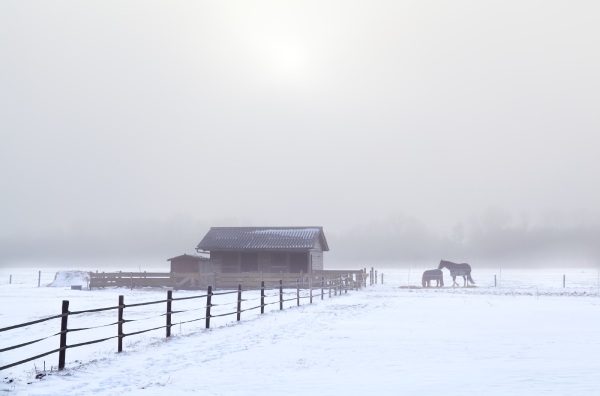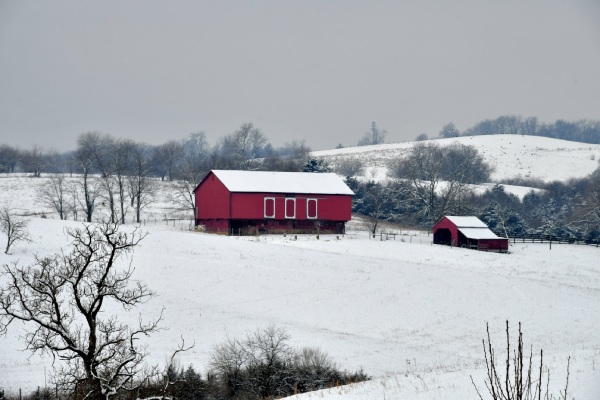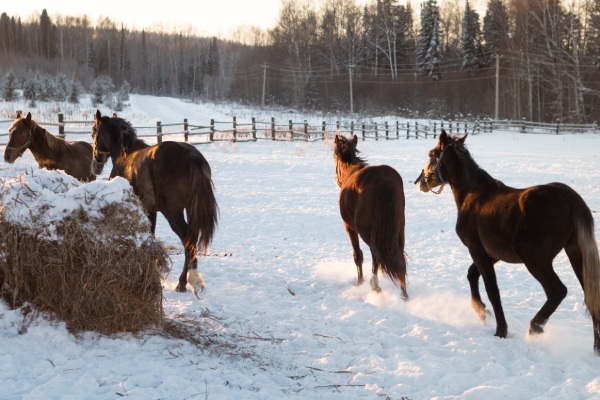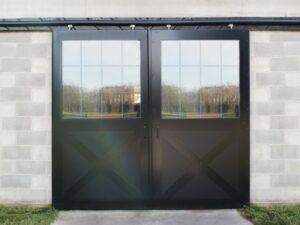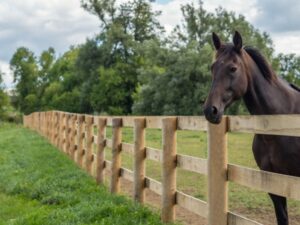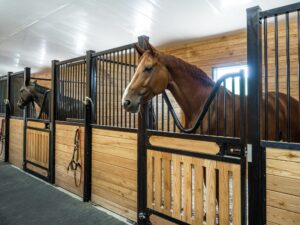When it comes to your farm, there’s no season quite like winter to leave you feeling anxious or overwhelmed.
With temperatures dropping, water freezing, and snow on the horizon, winterizing your barn has likely been on your mind.
The harsh Canadian winters can wreak havoc on your property and your horses without the proper care.
Preparing the various elements around your property is crucial to maintaining the health, safety, and comfort of your horses this upcoming season.
With proper planning and maintenance, you can ensure your property is ready, keeping it in prime condition and your horses comfortable and happy all season long.
To make this process as simple as possible, we’ve created an easy-to-follow guide for winterizing your barn and fencing.
Read on to discover the top factors you’ll want to consider as you prepare for winter!
Why is Winterizing Your Horse Barn Important?
Just like humans, winter can bring a host of issues for your horses, especially if they’re exposed to the bitter cold without the means to escape into the warmth.
From leaking water, iced-over buckets, or frozen hoses interrupting regular feeding routines, an improperly prepared barn can quickly become overwhelming, and potentially dangerous.
This is amplified by the unfortunate reality of our winters, with freezing rain, excessive snow, high winds, and well-below-zero temperatures.
During these times, your horse has a higher chance of developing numerous health issues, from thrush and colic to respiratory issues.
However, properly preparing your barn and its stables will help keep this risk low, while also reducing the impact the winter has on your routine chores.
So, what exactly should you be doing to get your barn ready for the upcoming season?
Let’s find out!
Your Step-By-Step Checklist for Winterizing Your Barn
Performing thorough inspections and repairing any signs of damage to your barn before the cold hits can save you from headaches after temperatures begin to plummet.
With the right steps, combatting this can actually be quite simple, but you’ll need to focus on a couple of important elements of your barn.
Winterizing Your Barn
First and foremost, you’ll want to focus on your barn as a whole, paying close attention to its structural integrity.
This goes far beyond the state of your beams and walls.
In fact, you’ll want to look at things like:
- Seals around doorways
- Electrical outlets and lights
- Wiring and extension cords
- Ventilation
- Gutters
Seals Around Doorways
While your horses are tough, keeping drafts at bay is a must, especially during those long winter nights when the temperatures reach extreme lows.
As you inspect your barn, look at things like windows and doors, checking for any drafts that may be coming in.
If you’ve found any that are letting in cool air, consider adding a new seal around them.
Electrical Outlets and Lights
Winter comes with long nights, which means you’ll be doing chores after dark much more often. For many, this means turning on the lights for the first time since the spring.
This makes it incredibly important to inspect and ocean your electrical outlets and lights, ensuring they are working as expected.
Not only does this ensure you’ll be able to see as you move through your evening chores, but your electrical outlets are in good working order to maintain the safety of your barn.
Wiring and Extension Cords
This goes hand in hand with the first flicker of your lights for the season. Your wiring is susceptible to damage from rodents that may have gotten into your barn.
Prior to flicking on the lights for the first time, do a thorough inspection of your wiring, looking for any signs of damage.
If you find any, take the time to get it repaired before winter hits. This will help ensure you get any wiring issues fixed early, reducing the risk of fire hazards.
Ventilation
When it comes to your horse’s respiratory health, the ventilation in your barn is crucial.
Over the winter, your barn will be susceptible to an influx of moisture from the rain, snow, and general dampness throughout this season.
Without proper ventilation, this can lead to a range of health concerns for your horse.
Before winter hits, inspect the ventilation system for your barn and ensure it’s properly functioning.
This will ensure you’ll be able to remove the moisture that builds up, keeping your barn comfortable and safe for your horses all season long.
Gutters
Lastly, you’ll want to check your gutters and give them a good clean before the temperatures begin to drop.
As fall continues, your gutters can quickly become clogged with leaves and debris carried by the wind.
Without cleaning this out before winter, you risk it freezing, reducing the drainage, and opening yourself up to the potential of leaks throughout your barn.
Alongside the structural elements of your barn, you’ll also want to consider the functional aspects of your barn, with water pipes and hoses being at the top of your list.
To keep freezing water from wreaking havoc on your barn, consider including these aspects in your winterization process:
- Add foam insulation to your pipes
- Install electrical heat tape on taps
- Invest in heated buckets (and use a dedicated electrical outlet for them)
- Drain all “summer-only” water lines
Preparing Your Stables and Stalls
Now that you’ve worked your way through winterizing the barn itself, let’s turn our focus toward your stables and stalls.
Your horses will be spending much more time in their stalls once the temperatures drop, so you’ll want to ensure their space is prepared to keep them engaged and comfortable.
To start, look at the stable itself. Ask yourself the following questions:
- Are there any broken boards or grills that need to be repaired?
- Is there rust on any of the steel channels and edging?
- Did your stalls flood during the spring or summer?
- Is the flooring torn or damaged?
If you answered yes to any of these questions, you’ll want to take the necessary steps to repair the damage and ensure the safety and comfort the space provides.
You’ll also want to check any windows near the stalls and ensure there are no drafts and they are protected by grills.
Additionally, to keep boredom and destructive behaviours at bay, consider installing slow feeders or investing in some stall toys like Likit Boredom Busters or Jolly Hay Balls.
Tips to Winterize Your Paddocks and Fencing
After you’ve ensured your barn is ready to withstand the upcoming season, it’s time to prepare your paddocks and fencing–after all, your horses won’t be staying inside for the entire season!
Fencing
To start, take a walk around your paddock and inspect your fences. Look for any exposed nails or screws, or boards that may have become damaged and are now sticking out, and repair them.
If you have electric fencing, check the output voltage and ensure there are no shorts.
Gates
After you’re confident your fences are in good shape, you’ll want to consider your gates.
Did they get stuck in the snow last year? Were you constantly battling to open them after they froze on the ground?
If so, take the time to rehang them a few inches higher to ensure you’re not fighting to move your horses in and out of the fields.
Furthermore, check the latches for your gates as well to ensure they are functioning as expected and aren’t in need of being replaced.
Feeding and Weather Protection
Finally, take time to consider the elements within your paddock, such as feeders, troughs, and shelters.
To keep boredom at bay, consider adding slow feeders. This will keep your horses chewing longer, extending their feeding to help reduce any potentially destructive behaviour that surfaces when boredom arises.
This is also a good time to consider investing in a heated trough. This serves two purposes.
First, it’ll help ensure the water doesn’t freeze throughout the day, reducing the amount of de-icing you need to do each day.
Secondly, it helps ensure your horses stay hydrated while they’re outside. This is especially important for horses that spend the majority of their day outside.
Horses have a tendency to forgo water that’s too cold. Having a way to keep the water at ideal temperatures (18-20℃) during the winter is crucial in keeping them healthy all season long.
Lastly, while your horses will be spending plenty of time in their indoor stalls, you’ll need to ensure there is an area in your paddock that provides them protection from the elements.
One of the best ways to do this is through a 3-sided shelter. This gives them a place to escape the sharp wind and snow during cooler days.
Winterize Your Barn Alongside The Experts at System Equine
Winterizing your barn and fencing is a crucial responsibility for any horse or stable owner.
By taking the time to prepare your property before the first snowfall, you can ensure the health and well-being of your horses, while reducing the impact the season has on your chores.
Whether you’re looking to update your stalls or make repairs to ensure they’re in the best condition possible, System Equine is here to help.
With our wide range of products for your horse, barn, and property, we’re your one-stop shop for all of your equine needs.
Our team of experts can help you find everything you need to create a safe, comfortable winter season for your horses.
Contact us, or visit us at our Rockwood store today.
